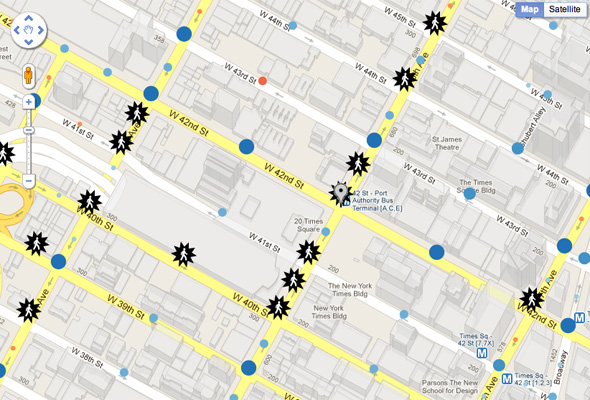
As you set out on your holiday shopping this year, watch where you step — and if you’re in Community District Five, look both ways. Twice.
The advocacy organization Transportation Alternatives (TA) has made a color-coded list of the most dangerous Community Board districts for pedestrians, which is available in their “Walking in Traffic Violence” report. Community District Five, which runs from Lexington to Eighth Ave. and 14th to 59th St., was at the top, with 8,604 accidents in a 15-year period and a “code red” designation.
Nearby Community Board Four covers areas between 14th and 59th St. west of Eighth Ave., north of 26th St. and west of Sixth Ave. With 3,581 traffic accidents in the district for the same timeframe, the area fell within code orange.
In addressing concerned residents at a recent West 44th Street Better Block Association meeting, Borough President Scott Stringer carefully explained his views on managing traffic in CD4. One resident asked about the possibility of implementing new bike lanes.
“We want to be a progressive city, and I do think there is a great need to have bike lanes where appropriate,” said Stringer, while acknowledging that they can pose a danger to the elderly and infirm. “For some people, it’s Russian roulette out in the streets.”
According to Department of Transportation (DOT) statistics, pedestrians accounted for 52 percent of all traffic fatalities from 2005-2009. A DOT report that contains an analysis of over 7,000 crash records says all fatalities dropped by over a third between 2001 and 2009, but some residents don’t trust the numbers.
Founder of pedestrian rights group Chekpeds, Christine Berthet, who is also the first vice chair of Community Board Four and co-chair of its Transportation Planning Committee, says that pedestrians are actually in more trouble than they used to be, not less.
“In fact, traffic accidents involving pedestrians and bicyclists went up,” Berthet said. “The problem is that DOT loves to merge the statistic of drivers and passengers killed as well as pedestrians, and because of progress in the technology of cars and the safety of cars, we [see a decrease in fatalities for] car drivers and passengers.”
The DOT study notes that “pedestrians are 10 times more likely to die than a motor vehicle occupant in the event of a crash.” In addition, driver inattention was the cause of nearly 36 crashes that resulted in pedestrian fatalities or injuries. Drivers failing to yield accounted for 27 percent of pedestrian fatalities.
Last month, TA relaunched its website, CrashStat.org, where New Yorkers can find traffic accident data from 1995-2009 plotted on a map of the five boroughs. The map shows the most dangerous intersections, complete with symbols that signify how many accidents happened at each location.
“We designed the site because we have people contact us, and we meet people all the time, who know of a dangerous street they want to see changed,” said Lindsay Ganson, campaign coordinator. “Really, we see it as a tool for people to back up their firsthand experience with the facts, the history of those streets.”
Ganson does commend the DOT for their aggressive public education program, which includes a campaign reminding New Yorkers to obey the speed limit and one called “Don’t be a Jerk!” which playfully reminds bicyclists to ride responsibly.
“Walking in Traffic Violence” states that 69 percent of fatal crashes with known causes are caused by poor driver behavior: speeding, running red lights, failure to yield and other violations. The report concludes that police should “prioritize enforcement against driver behaviors that put pedestrians at risk.” Michael Murphy, the organization’s director of communications, says that bolstering enforcement would lower the numbers.
“There is no other city where you can say ‘didn’t see ’em’ and you’re fine,” said Murphy. A study released in September by two Hunter College professors revealed that 500 pedestrian injuries were caused by bicyclists each year. According to a report issued by TA and the Drum Major Institute for Public Policy, recent DOT street design improvements – including curb extensions, pedestrian refuge islands, speed bumps and bicycle lanes – have been proven to reduce traffic injuries and fatalities. The study also recommends safe speed detectors as a cost-effective speeding control method.
Berthet agrees with DOT figures in respect to what the most dangerous intersections are: 42nd St. and Eighth Ave. and 42nd St. and Ninth Ave., which are located near a school, a daycare and a senior center.
According to Community Board 4 board member James Wallace, the traffic troubles of Hell’s Kitchen are no secret.
“I was almost hit by a car the other day,” he said after a recent 44th Street Better Block Association meeting. The encounter occurred on 40th St. and Ninth Ave. “I was coming up from the fish market and a car was making a right turn – and was more interested in making this turn than in seeing if there was anyone in the crosswalk. It was moving slowly, but it was a minivan. I could have reached out and touched it.
“This is a dangerous neighborhood for pedestrians,” he added. “When traffic isn’t bad, it moves at a high rate.”
DOT hopes to cut the number of 2007 traffic fatalities in half by 2030. Two DOT representatives could not be reached by phone or email by deadline.